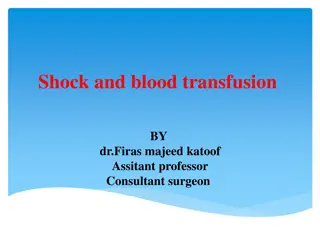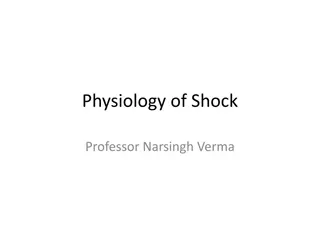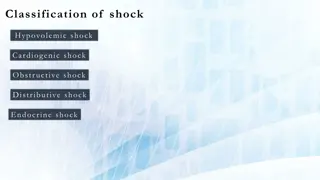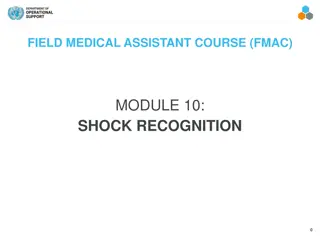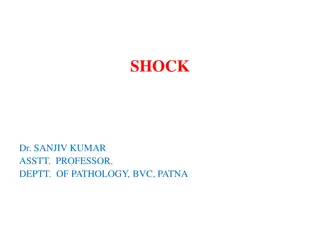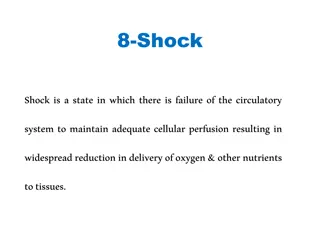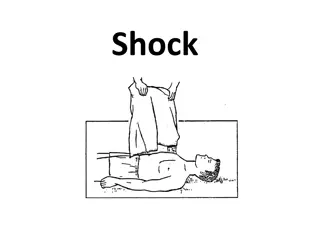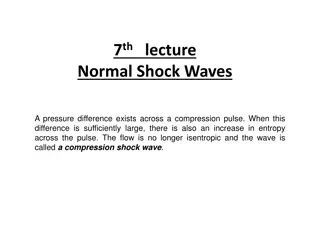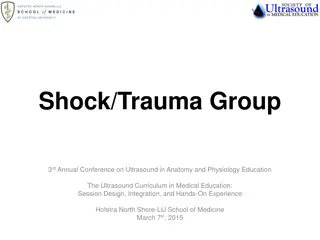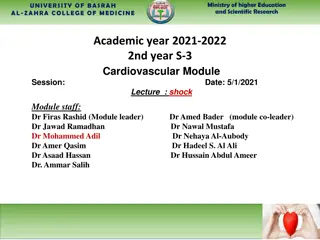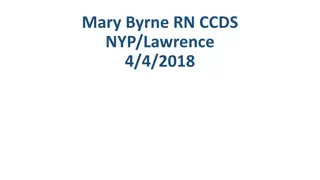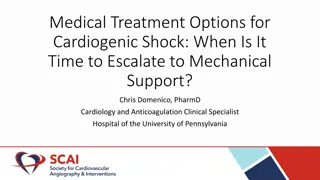stages of shock progression
The pathophysiology of shock involves inadequate blood distribution to vital organs, leading to stages of shock - initial, compensatory, progressive, and refractory. Different types of shock include hypovolemic, cardiogenic, anaphylactic, septic, and neurogenic shocks.
Download Presentation

Please find below an Image/Link to download the presentation.
The content on the website is provided AS IS for your information and personal use only. It may not be sold, licensed, or shared on other websites without obtaining consent from the author.If you encounter any issues during the download, it is possible that the publisher has removed the file from their server.
You are allowed to download the files provided on this website for personal or commercial use, subject to the condition that they are used lawfully. All files are the property of their respective owners.
The content on the website is provided AS IS for your information and personal use only. It may not be sold, licensed, or shared on other websites without obtaining consent from the author.
E N D
Presentation Transcript
Pathophysiology The amount of blood is small and the heart cannot find blood until it is pumped to the vital organs. As for the amount of blood present, it is normal, but the heart cannot pump to the vital organs, which means the problem is in the heart. Or the heart is healthy and the amount of blood is normal, but the poor distribution in the blood of the important vital organs such as the brain, kidney, heart and lung does not deliver the blood naturally, but the unimportant organs reach them naturally
Stages of shock 1.Initial stage When vital organs have little amount of oxygen rather than depend on aerobic metabolism that depends on oxygen and produce energy, it metabolism, resulting in lactic acid, a lot of and pyruvic acid, which causes metabolic acidosis . will depend on anaerobic
Stages of shock 2.Compensatory stage Here the body is trying to correct the acidity of the blood on the one hand and trying to deliver the blood to the organs for vitality on the other hand The result of the sympathetic nervous system: Adrenaline peripheral vasoconstriction tachycardia + tachypnea
Stages of shock 3. Progressive stage This stage occurs as a result of the second stage if it fails and the body cannot compensate for this deficiency because the reason is still present and therefore the lactic acid and metabolic acidosis increase . Decrease blood pressure and fluid exits from the capillaries around it and the movement of blood decreases, thus oxygen and nutrients are very less for the vital organs.
Stages of shock 4. Refractory stage Irreversible stage For example: permanent malfunction or death of brain cells
The main types of shock include: Hypovolemic shock (caused by too little blood volume) Cardiogenic shock (due to heart problems) Anaphylactic shock (caused by allergic reaction) Septic shock (due to infections) Neurogenic shock (caused by damage to the nervous system)
Hypovolemic shock Hypovolemic condition in which severe blood or other fluid loss makes the heart unable to pump enough blood to the body. This type of shock can cause many organs to stop working. shock is an emergency
Hypovolemic shock causes Blood loss can be due to: Bleeding from cuts or RTA Bleeding from other injuries Internal bleeding, such as in the gastrointestinal tract Varicose(Esophageal varices( Fluid loss can be due to: peritonitis Burns Sever Diarrhea &Vomiting Diuretic too much use Excessive perspiration
Hypovolemic Shock Sign And Symptoms Tachycardia Weak pulse Pale skin Cold extremities Tachypnea Delay capillary refill time < 2sec Decrease skin turgor Dry skin and mucous membrane Low blood pressure Decrease urine out put Altered mental status
Exams and Tests Exam: Low blood pressure Low body temperature Rapid pulse, often weak and thready Tests : Blood chemistry, including kidney function tests Complete blood count (CBC) CT scan, ultrasound, or x-ray of suspected areas Echocardiogram - sound wave test of heart structure and function Electrocardiogram Endoscopy - tube placed in the mouth to the stomach (upper endoscopy) or colonoscopy (tube placed through the anus to the large bowel) Urinary catheterization (tube placed into the bladder to measure urine output)
Treatment ABC Airway Breathing Circulation 2 line (cannula) Oxygen Fluid 500 1000 (1-2 liter b0lus NACL) Urinary catheter monitor
Symptoms and outcomes can depending on: Amount of blood/fluid volume lost Rate of blood/fluid loss Illness or injury causing the loss Underlying chronic medical conditions, such as diabetes and heart, lung, and kidney disease, or related to injury
Role of nursing Keep the person comfortable and warm (to avoid hypothermia). Have the person lie flat with the feet lifted about 12 inches (30 centimeters) to increase circulation. However, if the person has a head, neck, back, or leg injury, do not change the person's position unless they are in immediate danger. Do not give fluids by mouth. If person is having an allergic reaction, treat the allergic reaction. If the person must be carried, try to keep them flat, with the head down and feet lifted. Stabilize the head and neck before moving a person with a suspected spinal injury.
complications Kidney damage (may require temporary or permanent use of a kidney dialysis machine) Brain damage Gangrene of arms or legs, sometimes leading to amputation Heart attack Other organ damage Death
Cardiogenic shock Cardiogenic shock takes place when the heart has been damaged so much that it is unable to supply enough blood to the organs of the body. Causes: myocardial infarction MI Cardiopathy Cardiac tamponade Tension pneumothorax arrhythmia
Sing and symptoms Chest pain or pressure Coma Decreased urination Fast breathing Fast pulse Heavy sweating, moist skin Lightheadedness Loss of alertness and ability to concentrate Restlessness, agitation, confusion Shortness of breath
Symptoms depended on cause Congested neck vein Congested liver (pain in right upper quadrent) Crackles cyanosis
Exam and Tests Exam will show: Low blood pressure (most often less than 90 systolic) Blood pressure that drops more than 10 points when you stand up after lying down (orthostatic hypotension) Weak (thready) pulse Cold and clammy skin Tests include: Cardiac catheterization Chest x-ray Coronary angiography Echocardiogram Electrocardiogram
Lab tests include: Arterial blood gas Blood chemistry Cardiac enzymes (troponin, CKMB) Complete blood count (CBC) Thyroid stimulating hormone (TSH)
Diagnosis depended on cause MI--------- ECG + cardiac enzyme Pneumothorax----------- chest X- ray Cardiac tamponade------- ECHO
TREATMENT IN ER ABC 2 cannula Oxygen Fluid Urinary catheter
Treatment The goal of treatment is to find and treat the cause of shock to save life. may need medicines to increase blood pressure and improve heart function, including: Dobutamine Dopamine Epinephrine When a heart rhythm disturbance (dysrhythmia) is serious, urgent treatment may be needed to restore a normal heart rhythm. This may include: Electrical "shock" therapy (defibrillation or cardioversion) Implanting a temporary pacemaker Medicines given through a vein (IV)
Pain medicine Oxygen Fluids, blood, and blood products Other treatments for shock may include: Cardiac catheterization with coronary angioplasty and stenting Heart monitoring to guide treatment Heart surgery (coronary artery bypass surgery, heart valve replacement)
Possible complication Brain damage Kidney damage Liver damage



